299 posts
Latest Posts by curiositytherover - Page 6



A major breakthrough could let both same-sex partners be biological parents to their kids
Could two same-sex partners ever be biologically related to one baby? Maybe. With a relatively new process called in vitro gametogenesis, or IVG, scientists could combine genetic material from both parents. While we may have to wait a bit for it — here’s how it works.

Flying Through an Aurora, another astounding image captured by ESA astronaut Alexander Gerst http://space-pics.tumblr.com/





Wow. NASA has released some amazing images of Saturn’s icy moon Enceladus.






Almost a month ago, the spaceflight company Blue Origin sent a rocket up to the edge of space and then guided it gracefully back down to earth, intact. It was a historic first.
But Blue Origin’s major competitor, SpaceX, was quick to point out that the rocket wasn’t going fast enough (or sideways enough) to place a satellite into orbit - just 4,600 kph (~2,860 mph). It went straight up, and then straight down.
Now, SpaceX has managed to put 11 satellites in orbit with a “reusable” rocket. Their rocket didn’t just go up and down - it reached a horizontal velocity of 6,000 kph (3,600 mph) before returning to earth. If SpaceX is able to refurbish the rocket and use it in another launch, they’ll have figured out a way to dramatically reduce the cost of spaceflight.
Here’s the full webcast. And here’s the full story.
Video credit: SpaceX

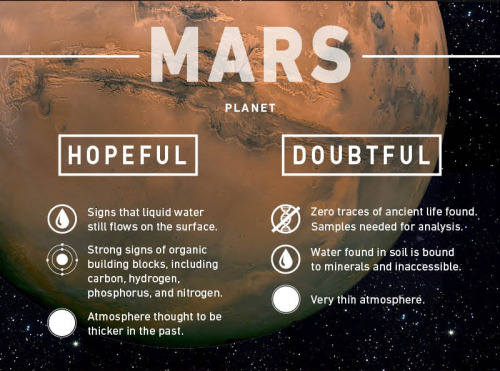
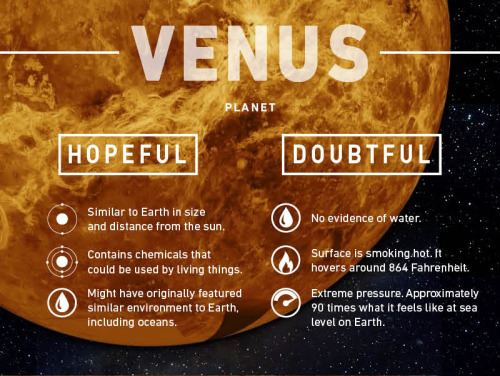
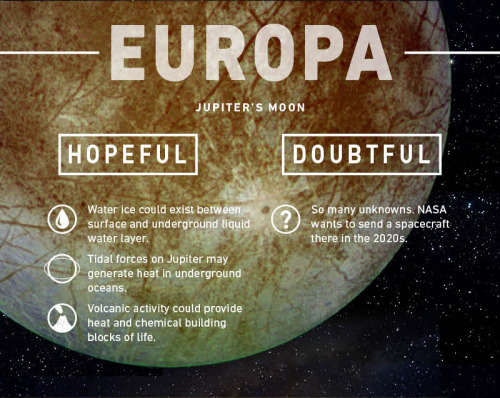
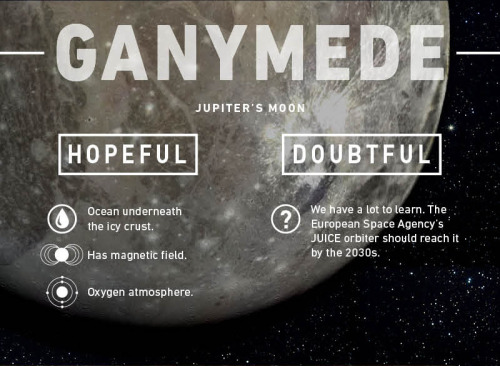



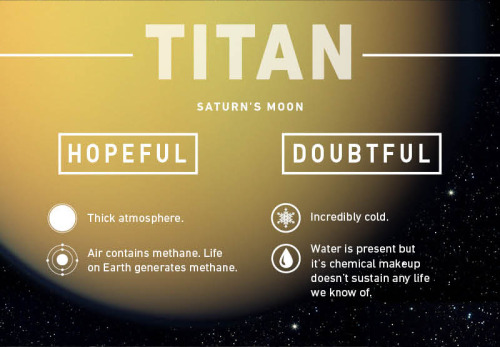
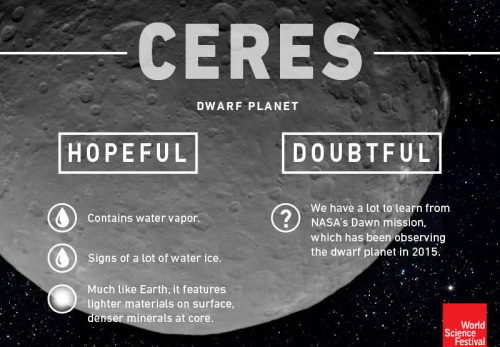
Where Could Life Exist?
When NASA scientists announced earlier this year that they had found evidence of liquid water on Mars, imaginations ran wild with the possibility that life could exist somewhere other than here on Earth.
Scientists continue to explore the possibility that Mars once looked a lot like Earth — salty oceans, fresh water lakes, and a water cycle to go with it. That’s exciting stuff.
So where else are they looking? What exactly are they looking for?
There are nine places in our universe where scientists say life is a possibility. The locations range from a smoking hot planet like Venus to a moon that orbits Saturn called Enceladus, which looks a lot like a massive, tightly-packed ball of ice.
All of these places show signs that water is, or at least was, a possibility. They also appear to feature some kind of energy that could produce heat.
full resolution




Just because you can’t see it doesn’t mean mental illness don’t exist.
www.thebpmag.com
PSYCHOLOGY FACT #27
Seeing others positively reveals our positive traits, seeing others negatively reveals our negative traits.
Keep reading

For everyone whoever answered “Astronaut!” to the “What Are You Going to Be When You Grow Up?” question, now is the time to make that dream come true: NASA is “looking for the best candidates to work in the best job on or off the planet,” according to a Dec. 14 job post. Until Feb. 18, 2016 all qualifying U.S. citizens may apply to join the National Aeronautics and Space Administration’s next class of astronauts on a red planet adventure.
“NASA is on an ambitious journey to Mars and we’re looking for talented men and women from diverse backgrounds and every walk of life to help get us there,” said Charles Bolden, NASA Administrator and real, live (former) astronaut, according to the job listing. “Today, we opened the application process for our next class of astronauts, extraordinary Americans who will take the next giant leap in exploration.” The mission: According to Bolden, “this group will launch to space from U.S. soil on American-made spacecraft and blaze the trail on our journey to the Red Planet,” specifically, on board Orion and two commercial crew space vehicles. “NASA astronauts will again launch to the International Space Station from Florida’s Space Coast on American-made commercial spacecraft — Boeing’s CST-100 Starliner and the SpaceX Crew Dragon. These spacecraft will allow NASA to add a seventh crew member to each station mission, effectively doubling the amount of time astronauts will be able to devote to research in space, expanding scientific knowledge and demonstrating new technologies,” Bolden said in the listing. The Boeing and SpaceX will be ready for liftoff from Florida’s Cape Canaveral beginning in 2017, NBC reports.
Continue Reading.

Roller Coaster Physics.
The principle that underlies the working of a roller coaster is simple. As you ascent to the top, your potential energy builds up. ( i.e the higher you go, longer the distance that the force of gravity can act upon)
This built up Potential energy gets released as kinetic energy downhill. ( Kinetic energy is the energy of motion- linear and rotational).
Now what Roller Coaster Engineers do is abuse this principle to engineering perfection.
Come watch this
So there’s supposed to be this amazing meteor shower tonight, but it’s raining and cloudy where I am and I’m pretty disappointed. I’ll have to watch the live stream.

Area of a circle
Interactive version:
http://www.malinc.se/math/geometry/circleen.php




Last Minute Geeky Gifts for the Science Lover in Your Life
Once again, the holiday season is upon us. Unfortunately, this leaves a lot of us at a loss. First, it’s easy to get bogged down by the commercialism that surrounds the season. Second, it’s sometimes difficult to find something that is really meaningful. To that end, here are some science themed gift ideas that you can get your loved ones (or maybe use as a treat for yourself). Some are educational, others are science based charitable contributions, all of them are pretty awesome.
Read more about the fascinating gifts at: http://futurism.com/links/geeky-gifts-for-the-science-lover-in-your-life/
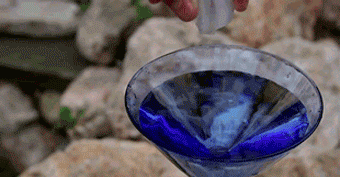

Studies show that people decide if you’re trustworthy, adventurous, successful, smart, extroverted, or likeable within 3 seconds of meeting you. Source

This stretchy, drug-delivering gel could be the Band-Aid of the future
Researchers in the US have developed a sticky, stretchable gel-like material that can be used as a “smart wound dressing”. Incorporating temperature sensors and drug reservoirs, the hydrogel bandage can release medicine in response to changes in skin temperature, and embedded LEDs even light up to let you know when your meds are running low.
The hydrogel matrix that makes up the dressing has numerous advantages over conventional cloth-based bandages. It’s highly flexible and stretches easily so can be applied to any area of the body, including joints like elbows or knees.
- ScienceAlert



The Geminid meteor shower is back and will peak on Sunday and Monday this week. It’s supposed to be one of the most promising events of the year with roughly 50 shooting stars an hour. How, when and where to watch the spectacular event.

End texts with a period if you want to seem like a jerk

Why the Brain Makes Mistakes
A study conducted at Carnegie Mellon University investigated the brain’s neural activity during learned behavior and found that the brain makes mistakes because it applies incorrect inner beliefs, or internal models, about how the world works. The research suggests that when the brain makes a mistake, it actually thinks that it is making the correct decision—its neural signals are consistent with its inner beliefs, but not with what is happening in the real world.
The research is in eLife. (full access paywall)

Google uses Pixar’s ‘Inside Out’ to teach girls programming

Today in Futurism! - What it will take to get to mars: 8 must have technologies. Read more at: futurism.com/WTtgU - Scientists develop paper that can store energy. Read more at: futurism.com/LUeAe

Hi guys! I was inspired to make this post by all of the messages I’ve gotten from people asking me to either tag or stop posting images of spiders all together. And as someone who used to be absolutely mortified by any 8-legged creature, I can see where you are all coming from! I used to have a bedroom in the attic, a musky basement, an exotic plant and flower garden, and lots of wood piles. So it’s no wonder that I was confronted with spiders of all shapes and sizes. Ranging from the wolf spider, the brown recluse, cellar spiders, and all kinds of orbweavers. Spiders are incredibly important to our ecosystem, and without them we would suffer. They are incredibly complex and fascinating little creatures that, whether we like it or not, are going to cross our path. What helped me come over my fear the most was simply taking the time to learn about them.

1.) You swallow spiders in your sleep: FALSE. Might as well start with the one we’ve all heard! There would have to be so many unlikely circumstances for this to happen that it’s pretty implausible. Most spider species prefer to stay in their webs, while others hunt no where near humans. Beds don’t offer prey so they likely won’t crawl into them intentionally, unless you have other bugs in your bed for whatever reason. Spiders already could care less about us, they definitely won’t be crawling into a moist, slumbering and snoring human mouth. 2.) Two puncture marks means a spider bite: FALSE. Spiders do have two venom-injecting fangs that they usually use at the same time when biting. However, any spider smaller than a tarantula will leave bites so small that there will be no identifiable separation, if a mark is even left at all. When you have two bites right next to each other, it’s probably from a different bloodsucking insect that has bitten you twice. 3.) Daddy Long Legs have the most powerful venom, but its fangs are too small to bite you: FALSE. This is another wildly accepted urban legend with no fact behind it whatsoever. Depending on where you’re from, you may have a different idea of what a Daddy Long Leg is. To some it is a Harvestman while to others it is a Crane Fly; both have no venom! To others it is a Pholcid House Spider, which does have venom, however it is extremely weak. 4.) You’re always within 3 feet of a spider: FALSE. There’s actually some history behind this one! According to an article from the Burke Museum, it started in 1995 when a famous arachnologist stated, “Wherever you sit as you read these lines, a spider is probably no more than a few yards away.“ Throughout the years this line as been repeated with the distance becoming shorter and shorter. In reality, nobody can really say how far you are from a spider at any time. Just remember that spiders don’t really care about you are are likely to ignore you and go about their business. 5.) Spiders can lay their eggs under human skin through their bites: FALSE. First of all, spiders do not find the human body suitable for egg laying. However there are tons of stories claiming that someone’s “friend” had it occur to them (usually by a brown recluse, which prefer to stay far away from humans as their name suggests). Spiders simply don’t have the ability to somehow transfer their eggs into their venom. 6.) Any spider species can be found anywhere: FALSE. Just like animals and insects, spiders prefer certain climates to thrive. Therefore this myth is completely false. Besides house spiders, many species have very limited ranges. For more information on spiders in your area, a quick Google search will do you much better. 7.) Spiders found in your home are dangerous: FALSE. Spiders are not bloodsuckers. They have no reason to bite humans or your beloved Fluffy. Rod Crawford, the Curator of Arachnids at The Burke Museum, has been handling thousand of spiders for 44 years. He claims to have been bitten a total of 3 times. The spiders that are typically found in homes do not obtain venom powerful enough to do you any harm. 8.) Spiders come indoors in the fall: FALSE. Arachnophobes may not like this, but, the spiders in your house have likely been there the entire time. Outdoor spider species are not adapted to the indoors, and vice versa with house spider species. Very few spiders you see in your home have ever been outdoors. 9.) Tarantulas are dangerous or deadly to humans: FALSE. Hollywood tends to paint tarantulas as evil beasts who actively seek out humans to bite. In reality, tarantulas are common furry pets who are easily handled. Their venom has very low toxicity to humans. Most people who have been bitten don’t report anything besides a quick “ouch”. The most “dangerous” thing about tarantulas is the hair on their abdomens, which they can flick off and spread into the air. Although, this only causes mild skin rashes and irritation to the eyes and nasal passages.

1.) There are approximately 38,000 known species of spiders (as of February, 2015). Scientists believe there are still many more to be discovered. 2.) Spiders are vital to the ecosystem. Most of us know that they eat harmful insects, but they also pollinate plants and recycle dead animals and plants back into the Earth. They are also an essential food source to other small mammals, birds, and fish. 3.) Not all spiders spin webs. However, they all have the ability to produce silk. 4.) Web-weaving spiders have claws at the end of each leg. This enables them to move around their webs without getting stuck! 5.) Spiders have blue blood. 6.) Giant trapdoor spiders are considered living fossils. This is because they are very similar to the spiders that lived 300 million years ago! 7. The world’s biggest spider is the Goliath Spider. It can grow up to 11 inches wide with up to 1 inch long fangs! But don’t worry; it only eats frogs, mice, and other small creatures. 8.) Spiders have an exoskeleton. While us humans have bones that are surrounded by our muscles, spiders have their bones on the outside to protect their muscles on the inside. Which kinda make more sense to me. Grasshoppers, lobsters, and cockroaches are just a few that also have exoskeletons. 9.) Spider legs use hydraulic pressure to move. Their muscles are able to pull their legs inward, but not out again. This requires pumping a watery liquid into the legs to move them back out. This is why dead spiders’ legs are curled in. 10.) Spiders sometimes use a line of silk to “fly” through the air. This is called “ballooning”. You probably remember all but three of Charlotte’s babies did this. 11.) Baby spiders are called spiderlings. Pretty adorable. 12.) Males risk being eaten by the females. Similar to insects, female spiders are usually larger. They tend to eat any small creature that comes along, including the males who just wanna get some. The males attempt to avoid this by plucking strands of the female’s webs or doing a little dance (jumping spiders, who knew they could get more adorable).

Now, I know overcoming fears does not come easily to everyone. It took me quite a while! So I’ve put together some ideas that helped me. Just remember that this may not help everyone. If your fear is complicating every day life it may be best to seek help from a professional. 1.) Watch YouTube videos of spider handlers. This, this step right here, was the most important for me. It all started with this video. This owner cared so much about his spider who was having difficulties molting. He took the time to attempt to help her get it off, and showed a huge amount of grief and compassion as it went on. As someone who used to be scared of spiders, this video showed me a different side. This person loved this spider just like I love my cat. I began watching and subscribing to more and more channels, and found that it helped me a lot. Some channels worth looking at are tarantulaguy1796, TarantulaAddict, Jon3800, and Frankus Lee. 2.) Observe live spiders. If you see a spider in your house or outside, take a deep breath and just watch it for a little bit (at a distance, if you’d prefer). Watch its legs and how it moves, its different body parts and what it seems to be doing. Just watch them. They’re not going to jump on you and start gnawing on your arm like a human corn-on-the-cob, I promise. 3.) Visit spider exhibits. Whether it be at an aquarium, zoo, or museum, take the time to take a walk through the insect and arachnid exhibits. There will often be someone there who knows a lot about them who you can talk to. As mentioned before, the more you learn about them, the less scary they become! 4.) Watch someone handle a spider, or handle one on your own! Okay maybe the second one is a big step to take right now. But a lot of spider handlers may let you touch their legs (which are a lot furrier than you’d think!). However, if you’re too afraid, it’s best to watch from a distance for a while or pay close attention to how the handler holds the spider. The first time I held a spider I was pretty scared, but I was more concerned with dropping it or hurting it. I was amazed at how not-creepy it was and I walked away with an awesome experience. Just remember to keep them away from your face and to wash your hands before and after to keep those pesky hairs from irritating you. 5.) Overall, take it slow. If you need to start with pictures, start with pictures. Then gifs. Then videos. Then live spiders. It’s all up to you. In reality, spiders do not want to bother you. They are not these crazy blood-thirsty creatures that Hollywood and myths make them out to be. Educate yourself and remind yourself how amazing and important these little 8-legged guys are! EDIT: Silly me I totally forgot to include my sources! Fascinating Facts About Spiders Amazing Facts About Spiders Explorit Science Center Rod Crawford Burke Museum Scientific American

Reviving Chivalry: Small Favors Can Yield Large Returns
Many people hold the door open for strangers. But what do people give in return?
The research is in Frontiers In Psychology. (full open access)

One minute blood typing
A collaboration between Monash University and Haemokinesis Pty Ltd has resulted in a momentous breakthrough in world health. The creation of a novel category of low cost paper diagnostics that can identify a person’s blood group in just one minute the innovation is named Group Legible Immunohematology Format (GLIF).
GLIF enables quick and easy blood typing, without the need for laboratory equipment, expertise or interpretation of results. Within one minute a written result is returned to the user. This concept can be used anywhere, by anyone, the applications are endless; third world countries, multi-trauma events, countries with heavy conflict to name but a few.
This Australian made and licenced technology was created following a long standing partnership between Monash University and Haemokinesis with funding provided by the Australian Research Council (ARC) under the criteria of a Linkage project.

Kim Goodsell was running along a mountain trail when her left ankle began turning inward, unbidden. A few weeks later she started having trouble lifting her feet properly near the end of her runs, and her toes would scuff the ground. Her back started to ache, and then her joints too.
This was in 2002, and Kim, then 44 years old, was already an accomplished endurance athlete. She cycled, ran, climbed and skied through the Rockies for hours every day, and was a veteran of Ironman triathlons. She’d always been the strong one in her family. When she was four, she would let her teenage uncles stand on her stomach as a party trick. In high school, she was an accomplished gymnast and an ardent cyclist. By college, she was running the equivalent of a half marathon on most days. It wasn’t that she was much of a competitor, exactly – passing someone in a race felt more deflating than energising. Mostly Kim just wanted to be moving.
So when her limbs started glitching, she did what high-level athletes do, what she had always done: she pushed through. But in the summer of 2010, years of gradually worsening symptoms gave way to weeks of spectacular collapse. Kim was about to head to Lake Superior with her husband. They planned to camp, kayak, and disappear from the world for as long as they could catch enough fish to eat. But in the days before their scheduled departure, she could not grip a pen or a fork, much less a paddle. Instead of a lakeside tent, she found herself at the Mayo Clinic in Rochester, Minnesota.
Continue Reading.

Glowing bandages can reduce the chances of antibiotic-resistant bugs

This is your closest look yet at a Kuiper Belt object

Staring at the sun does make you go blind. The lens in your eye concentrates the sun’s rays, which burn a permanent blind spot into your retina- just like ants under a magnifying glass. This effect is amplified during a solar eclipse.
It’s called solar retinopathy.
Source

Total Recall Sounds Great, But Some Things Should Be Forgotten
Imagine never again forgetting where you parked your car, or that last item you had on your grocery list, or why you walked into this room anyway. If you trust media stories about research currently under way at Defense Advanced Research Projects Agency (DARPA) to build an implantable device to restore memory, you might not have to worry about these memory lapses in the future.

Japan’s Venus probe gets a second shot on December 7th